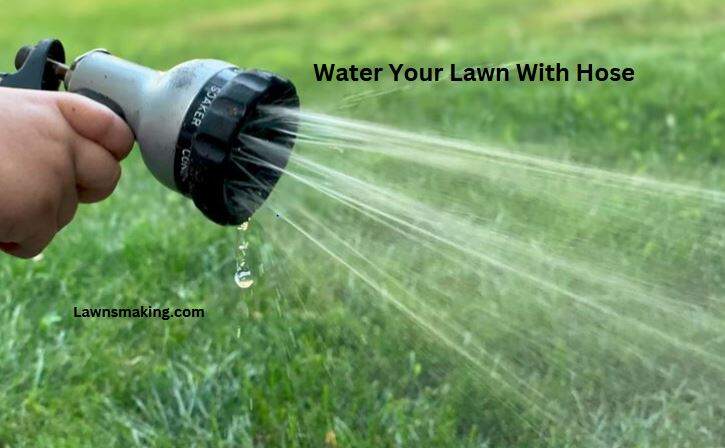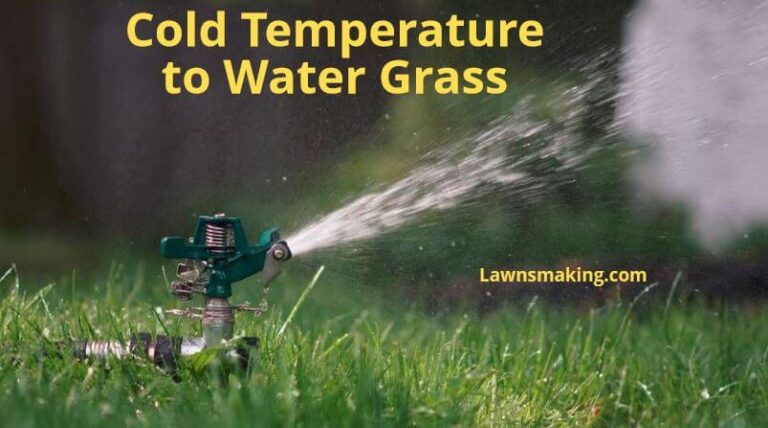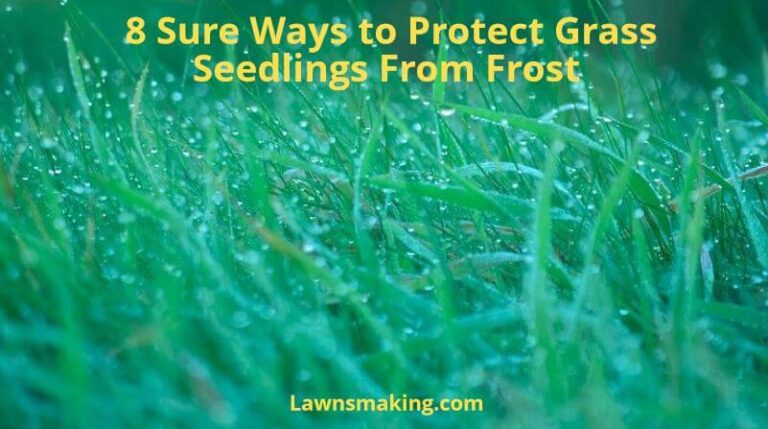
Are you tired of seeing your once lush, green lawn turn into a patchy brown eyesore? Does the thought of dragging out the hose to water your lawn feel like an arduous chore? If so, you might have found yourself wondering how to water lawn with hose.
To water your lawn effectively with a hose, attach a suitable nozzle, water deeply but infrequently, and opt for morning or evening watering sessions (when the temperature is 10-22 °C or 50-72°F) to mitigate evaporation. Also, pay attention to special (shaded, sloped, or elevated) areas to promote uniform growth.
In the rest of this article, I’ll discuss in detail how to water your lawn with a hose effectively. You’ll know the equipment needed and the right water techniques. Keep reading!
Mastering Lawn Watering With Hose: Everything you need to know
Proper lawn watering enhances your turf’s health and appearance, creating lush and vibrant outdoor spaces. Popular lawn watering methods include sprinkler systems, drip irrigation, and hose watering. Each watering method has its benefits and drawbacks.
You are in the right place to learn about lawn watering with hose. Most gardeners and homeowners opt for hose watering thanks to its versatility and accessibility. You can use hose watering on small, medium, and large lawns. The watering method is also suitable for all lawn shapes.
Moreover, controlled, targeted, and cost-effective watering is a reality with hose watering. Read on to get acquainted with the lawn watering method, starting with steps, techniques, and tips to ensure effective watering.
Find Out: Does Watering Grass in the Sun Burn It?
How to Water Lawn With Hose: Detailed Step-By-Step Guide

Step 1: Understanding Your Lawn’s Watering Needs
Getting acquainted with your turf’s watering needs is vital for maintaining its health and vibrancy. Factors like grass and soil type will affect how much and often you should water your lawn.
For instance, Bermuda lawns might require frequent watering. Likewise, sandy soil drains quickly, necessitating regular watering.
Additionally, gardeners and homeowners must be aware of under & over-watering signs. Wilting or browning grass and soil that feels dry to the touch are common under-watering signs. Alternatively, soggy or mushy soil and mold are the main signs of overwatering.
Find Out: What Temperature Is Too Hot to Water Grass?
Step 2: Equipment Needed
Selecting the ideal hose and accessories for your lawn’s size and shape allows you to ensure effective and efficient watering, promoting healthy growth and vibrant landscapes.
Hoses come in different forms to suit different lawn sizes and types. Traditional rubber hoses, expandable hoses, and soaker hoses are the most popular.
You can control water flow and pattern by selecting the ideal hose attachments, such as adjustable, spray, and fan nozzles.
Here are the necessary equipment you need to water your lawn with a hose:
- Garden Hose: Choose a hose of sufficient length to reach all areas of your lawn without having to constantly move the faucet. Hoses typically come in lengths ranging from 25 to 100 feet (7.62 to 30.48 meters). Consider the diameter of the hose as well; a larger diameter hose will deliver more water but may be heavier and less flexible.
- Hose Nozzle or Sprayer: A nozzle or sprayer attachment is essential for controlling the flow of water and directing it where it’s needed. There are many types of nozzles available, including adjustable spray patterns, watering wands, pistol-grip nozzles, and fan nozzles. Choose one that suits your watering preferences and the needs of your lawn.
- Water Source: You’ll need access to a water source, such as an outdoor faucet or spigot, to connect your hose. Make sure the faucet has a compatible thread size for your hose connector.
- Hose Connector: A hose connector is used to attach the hose to the water source securely. There are various types of connectors available, including threaded connectors, quick-connect fittings, and Y-connectors for multiple hoses.
- Water Timer (Optional): A water timer can be a useful addition to your watering setup, allowing you to automate the watering schedule and ensure consistent watering without having to monitor it manually.
- Hose Reel (Optional): A hose reel provides a convenient way to store and manage your hose, preventing tangles and prolonging its lifespan. Hose reels come in different designs, including wall-mounted, freestanding, and portable models.
- Watering Can (Optional): While not necessary if you’re using a hose, a watering can be handy for spot watering or for areas that are difficult to reach with a hose.
- Hose Repair Kit: It’s a good idea to have a hose repair kit on hand in case your hose gets damaged or develops leaks. These kits typically include hose menders, clamps, and sealing tape for quick repairs.
- Gloves and Protective Gear (Optional): Depending on the terrain and the type of vegetation in your lawn, you may want to wear gloves and protective gear to avoid injury from thorns, sharp branches, or chemical exposure if using fertilizers or pesticides.
Step 3: Preparation
Don’t rush into lawn watering. Instead, prepare the lawn and equipment for smooth and efficient watering. Start by clearing the turf of debris and obstacles, i.e., sticks and toys.
Other crucial preparation practices to incorporate include:
- Check the Weather: Make sure there’s no rain in the forecast. Watering your lawn just before rain is wasteful and unnecessary.
- Inspect the Hose: Ensure that your hose is in good condition without any leaks or kinks. If there are leaks, repair them using the hose repair kits.
- Attach Nozzle or Sprinkler: Depending on your preference, attach a suitable nozzle or sprinkler to the end of the hose. Nozzles provide targeted watering, while sprinklers cover larger areas.
- Check Water Pressure: Attach a pressure gauge to the garden tap and check the water’s pressure. Make sure the water pressure is appropriate for your watering needs. The ideal lawn watering pressure should be between 40 and 60 psi.
- Clear the Area: Remove any obstacles such as toys, rocks, or debris from the lawn to prevent the hose from getting tangled or damaged.
- Adjust the Hose Length: If necessary, unwind the hose to the appropriate length to reach all areas of your lawn without stretching or straining.
- Turn Off Automatic Systems: If you have an automatic irrigation system, ensure it’s turned off to avoid conflicting watering schedules.
- Plan Your Route: Decide on the best route for watering to cover the entire lawn efficiently. Start from one end and work your way across, overlapping slightly to ensure even coverage.
- Watering Time: It’s generally recommended to water early in the morning or late in the evening to minimize evaporation. This also helps prevent the growth of fungi and diseases.
- Observe Watering Restrictions: If there are watering restrictions in your area, make sure to adhere to them to conserve water and avoid fines.
- Watering Frequency: Understand the watering needs of your lawn based on factors like grass type, soil type, and weather conditions. Water deeply but infrequently to encourage deep root growth.
Step 4: Watering Techniques
You can ensure your lawn receives the right amount of water at the right time to promote healthy growth and a vibrant appearance.
Start by watering infrequently, providing 1.0 – 1.5 inches of water weekly. It will help to adjust the watering frequency based on soil moisture levels and weather conditions.
Move the hose and sprinkler regularly to cover all turf areas. Pay attention to slopes and uneven terrain, ensuring uniform watering.
Time your watering sessions in the calm early mornings to minimize evaporation and fungal growth. Also, time the watering sessions to allow the grass to dry before nightfall.
Step 5: Targeting Specific Areas
You can tailor your watering approach to specific areas to promote optimal growth and health. For instance, you can adjust watering patterns for sloped and uneven areas, which present water distribution challenges. As such, using a slow flow rate and staggering watering sessions are ideal ways of mitigating water runoff.
Additionally, you can opt for spot watering, which involves focusing on designated lawn areas that need additional moisture using a handheld sprinkler, watering can, or hose. Spot watering is ideal for newly seeded areas and dry patches that need consistent moisture for germination.
Step 6: Water Conservation Tips
Water conservation while maintaining a healthy lawn is vital to sustainability. Use a timer to control watering frequency and duration, ensuring you water only when needed.
You can also minimize water usage by adjusting sprinklers to avoid runoffs onto sidewalks and driveways or avoiding midday watering, which results in substantial evaporation losses.
Consider rain sensor installation, especially if you want to shut off sprinklers automatically when it’s rainy. Mulching using compost or shredded bark to retain moisture is another great way to reduce moisture evaporation and suppress weed growth, reducing the need for frequent watering.
Step 7: Troubleshooting Common Issues
You can’t maintain a lush, healthy turf without addressing common issues like fungal growth or brown spots resulting from over-watering, under-watering, and fungal infections. Understanding the underlying cause of brown spots is vital in addressing the issue.
Here is a table that can help you identify and address common turf issues:
| Issue | Solution |
| Over-watering | Reduce watering frequency and ensure proper drainage. |
| Under-watering | Increase watering frequency and adjust watering techniques. |
| Fungal Growth | Apply a fungicide according to the manufacturer’s instructions. Improve airflow by pruning overhanging branches or thinning dense vegetation. |
Did you know your lawn’s watering requirements change with the seasons? Consequently, increasing the watering frequency during hot summer months will prevent the grass from drying out. In contrast, reduce the watering frequency in cool months to mitigate fungal infections resulting from waterlogged soil.
Step 8: Maintaining Your Hose and Equipment
To ensure your watering equipment provides effective service for the years ahead, follow these maintenance tips:
- Regularly inspect and clean hoses and their attachments
- Watch out for signs of wear and tear or damage and leaks
- Repair or replace damaged and leaking spots
- Clean attachments to remove dirt and debris
- Properly coil and store your hose after each use
- Store the attachments separately to prevent damage
- Use storage bins to keep your watering equipment organized and protected when not in use
Additional Tips and Considerations
Understanding the basics of lawn watering allows gardeners and homeowners to meet their lawn watering requirements like professionals. Here are additional tips and considerations to level up your lawn care game:
Fertilizing Schedules in Relation to Watering
Coordinate your watering schedule with your fertilization routine. Post-fertilization watering is vital in nutrient activation. Moreover, watering after fertilization also helps nutrients sink into the soil for enhanced grass root absorption.
Consulting Local Water Regulations and Restrictions
Explore local water regulations and restrictions. Different jurisdictions have rules to help conserve water and protect natural resources. Researching and adhering to watering guidelines will make your lawn and environment happy.
Considering Alternative Watering Methods
Watering a lawn with a hose can result in significant water usage, especially if you have a sprawling turf. Fortunately, alternative watering methods like drip irrigation, smart sprinklers, and rainwater harvesting can reduce water usage.
Questions People Also Ask
Most green-thumbed souls and gardening enthusiasts waste no time in the garden of inquiries, especially as they seek answers to questions like:
What Is the Best Time To Water Grass?
The best time to water grass is in the early morning, generally before 10 AM. Morning watering sessions allow water to penetrate the soil deeply before the heat sets in, mitigating evaporation and facilitating optimal absorption.
You can also opt for evening watering sessions, preferably after 4 PM. Minimal sunlight intensity in the evening discourages evaporation, allowing proper water absorption.
How Do You Use a Lawn Sprinkler?
To use a lawn sprinkler, place (position) it in the center of your lawn, adjust the spray pattern, and turn on the water. Ensure even watering by mowing the lawn sprinkler periodically, typically every 20 to 30 minutes, depending on grass species and soil type.
What Is the Best Sprinkler System for a Large Lawn?
Rotary or oscillating sprinkler systems are the best choice for extensive lawns. These sprinklers are ideal for watering large lawns efficiently since they can guarantee even water distribution and proper hydration across expansive turfs.
What Are the Best Sprinklers for New Grass Seed?
For newly sown seeds, the best sprinklers are those that provide gentle and even water coverage without overwhelming grass seedlings. Therefore, oscillating sprinklers are ideal for new grass seeds since they emit a gentle mist-like spray that encourages root and shoot growth.
Final Thoughts
Our exploration of “How To Water Lawn With Hose” brings us closer to cultivating the vibrant and lush lawns of our dreams. Moreover, this detailed guide allows newbie gardeners and homeowners to master the art of lawn watering and selecting the perfect sprinkler for new grass seeds.
Proper watering techniques, timing, and consistency are invaluable in your quest for a green, healthy, attractive lawn. Meanwhile, mindful conservation practices help gardening enthusiasts discover a delicate balance between nourishing lawns with water and protecting natural resources.
Feel free to use the information here to improve your lawn care journey. Our comment section is for you. Use it to ask questions, share success stories, challenges, and invaluable watering with hose tips.





